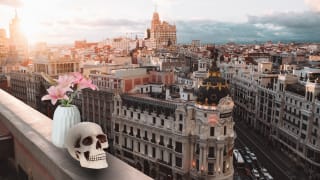The power of collaboration in place branding
Collaboration is the name of the game and Philadelphia are nailing it. From launching a new place narrative to driving their recovery after COVID-19, Sylvie Gallier Howard, the Acting Commerce Director at Philadelphia's Department of Commerce, shares how strategic collaboration has been central to their success.
Thank you for joining us, Sylvie. It’s hard to know where to begin – there are so many exciting initiatives Philadelphia is working on! Let’s start with Philadelphia’s Global Identity Partnership – could you give us a quick understanding of how that came about?
The development of our Amazon HQ2 bid was a process that ended up being a gift to Philadelphia. It required a large, cross-sector group of partner organizations to work together in a collaborative, coordinated way to present the very best of Philadelphia—that was something that hadn’t really been done before. It also allowed us to develop consolidated messaging, shared data points, and an engaging and visually oriented website that highlighted Philadelphia’s unique assets: talent, location, affordability, and livability. We were thrilled that our bid landed us a spot on the shortlist of finalists and garnered us a lot of increased attention.
Shortly thereafter, Philadelphia was selected by the Brookings Institution for their Global Identity Cohort, joining three other cities. In that process, we learned so much from the Brookings team and our peer cities about best practices in place branding—for business attraction and generally. One recommendation coming out of the cohort was the development of a collaborative process to solidify our global identity and develop strategies to amplify our unique identity to advance and enhance economic development efforts. Thus, the Philadelphia Global Identity Partnership was born with dozens of partners from a comprehensive swath of sectors and backgrounds.
How have you been fostering better collaboration across the Greater Philadelphia region?
I want to be clear that this entire effort has truly been group-led. The City of Philadelphia is only one player within a growing group of organizations and individuals from across the Philadelphia region who have joined this effort to better promote our assets to attract business, investment, and talent. Collaboration has been growing across the organizations involved, but the crisis presented by the COVID-19 pandemic has also accelerated cross-sector, cross-industry collaboration around the region, which will help speed Philadelphia’s economic recovery in the coming months.
Is there one thing that you think is key to successful stakeholder management?
There are so many aspects that you have to balance in a project that requires focused stakeholder management as the Philadelphia Global Identity Partnership, but I would say patience is key. That’s because collaboration is based on building trust—and that takes time. The Partnership is currently developing an online toolbox that would feature engaging visual assets, data points, and compelling messaging highlighting the Philadelphia region—all of which would then be available for organizations from various sectors to help tell the Philadelphia story to their own specific audiences. During this process, by focusing on relationship-building first, we prioritized building trust so that we had the most robust participation possible. We could have had three people in a room working on this quickly and then pushing it out, but that would defeat the purpose of truly adopting and promoting a shared, authentic global identity for Philadelphia that can be embraced by everyone involved.
As part of this project, you’ve launched a ‘new’ narrative for the city. What values did you think it was important to continue promoting, and has that been influenced by your new umbrella brand architecture?
The new narrative ended up reaffirming what many Philadelphians already knew in our hearts. I say this because it was a really positive thing that our identity was so strongly reaffirmed in the research and identity development process. Philadelphia impresses and surprises people when they visit, but ultimately at our core, the city and region is all about the people who live here. And Philadelphians are passionate. Passion is, and always has been, the fuel that sparks possibility in Philadelphia. Here, you can make a difference in a city that’s small enough to make an impact, but big enough that your impact matters.
Without a doubt, Philadelphia’s DNA encompasses not just our rich and unique history, diversity, and distinct personality, but also the fact that we have big city amenities coupled with the communal feel of a smaller city. Words like “grit,” “passion,” and “innovation” came up over and over in the research. Our city, along with the entire Philadelphia region, holds a special place in the history of our nation. That has shaped our values as a place to invent, reinvent, innovate, and trailblaze. Indeed, Philadelphia is a place where passion leads to possibility.
Aside from collaboration with your regional stakeholders, have you been building any partnerships with other destinations?
Absolutely. We have strong relationships with many other cities around the country and across the globe. While we maintain strong relationships with key Sister Cities like Tel Aviv, Frankfurt and Tianjin, our team has also developed a collaborative market prioritization strategy based on the needs and opportunities of regional stakeholders. Our global market strategy prioritizes trade and investment opportunities, while incorporating the top markets for tourism, international students, and venture capital attraction; air service development initiatives; support for immigrant populations; arts, culture and research partnerships; and complimentary innovation sectors. In 2019, the City of Philadelphia welcomed 139 delegations from 61 countries last year, including from Japan, Chile, Australia, India, and the United Kingdom. With Philadelphia’s proud, unwavering inclusiveness of all cultures, races, and orientations, we consistently promote the city as an international one where everyone is welcome.
Has this approach shaped your recovery strategy for the COVID-19 pandemic?
At the end of 2019, I had told myself that 2020 would be the year of collaboration because we can accomplish so much more when we—the public and private sectors along with anchor institutions—work together to find solutions. By including more perspectives at the table, we can identify even stronger solutions. When the COVID-19 pandemic began to impact Philadelphia, we immediately reached out to counterparts in surrounding suburban counties, along with our other partners on the ground. When businesses reach out to me asking how they can help, I always take the time to listen to and discuss their ideas, because I recognize that there is immense passion and desire to help. Smart, creative ideas can come from anywhere. We saw this when we were doing the work on the Amazon HQ2 bid, and we’re seeing it again now. We have so many leaders in the region who are doing incredible work and this is a time—now more than ever—when we need that. The prosperity of our city depends on us all developing a collaborative and innovative approach that will help rebuild a successful new economy for a new era in time.
I noticed on the City of Philadelphia website that you’re in the process of calling for applications for Playstreets. This is a decades-old project, but has it taken new significance in the light of the pandemic?
The Playstreets program is run by our Department of Parks & Recreation, which has been absolutely instrumental in keeping our public spaces safe and usable during the COVID-19 crisis. For nearly six decades, getting a meal at your local play street has been a reliable summertime staple for Philly kids and families. This summer, families are facing a lot of unknowns, but getting healthy meals to kids shouldn’t be one of them. Parks & Rec is calling on residents to consider applying to supervise a Playstreet.
All decisions for summer recreation plans are ultimately guided by public health guidance. However, Parks & Rec is working hard on ways to enhance Playstreets this summer, and will have more information to share once these plans are confirmed. With the uncertainty that still lies ahead this summer, we know that Playstreets will be more important than ever.
Across the world we’ve seen that destinations have been closing some roads to traffic and moving to more pedestrian and cyclist friendly public spaces. Is this something that you’re looking at? What do you think the future will be for public spaces after the pandemic?
My colleagues in the Managing Director’s Office have considered similar proposals, and conducted outreach to other cities that have implemented more open streets. Their outreach confirmed that, because of the many challenges we are facing, the City of Philadelphia is not equipped to advance such a plan right now. The biggest concerns at the time are the commitment of staff time, as well as material fabrication and deployment to safely close streets. Given our emergency management responsibilities, efforts to maintain core services, and the need for significant budget cuts in the upcoming fiscal year, Philadelphia cannot currently commit to additional resources to “open” streets.
As with many other areas, the post-COVID future for Philadelphia’s public spaces remains unknown, but there is great potential to reimagine their future. Right now, open public spaces such as parks are more important than ever for residents to maintain physical and emotional wellbeing. Luckily, Philadelphia has been able to keep our parks and trails open while promoting social distancing and other key safety protocols.
To avoid overcrowding and maintain safety, we are communicating some key advice to park users:
- Stay home if you are sick, or showing or feeling any COVID-19 symptoms.
- Practice social distancing. This means keeping at least 6 feet (roughly two park benches) of distance between yourself and others.
- Do not attend any gatherings or participate in any group sports in parks. Picnics, sports games, and even group hikes and group bike rides are not permitted.
- After being outdoors, wash your hands for at least 20 seconds with soap and warm water, or use a hand sanitizer with at least 60% alcohol.
- Avoid unnecessary contact with benches, handrails, or any other surface that is regularly touched.
- Try to recreate locally—if you have to take a car, the park is too far.
- Limit park visits to 60-90 minutes in order to make space for others.
- Bring a mask and keep it on you; wear it if you are within 6 feet of other visitors.
Our playgrounds and athletic courts remain closed, and we know that when they eventually reopen, new protocols will need to be put in place. The team at Parks & Recreation is working with the Department of Public Health now to prepare for a safe reopening when the city is ready.
Thank you for sharing that with us, Sylvie.
Related reading:
Crisis management of the COVID-19 pandemic: the impact on nation brands









